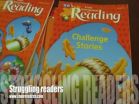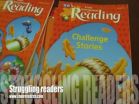(Press-News.org) VIDEO:
Children identified as intellectually disabled or with low IQ learned to read at a first-grade level after persistent, intensive instruction from a scientifically based curriculum. The findings of the pioneering...
Click here for more information.
The findings of a pioneering four-year educational study offer hope for thousands of children identified with intellectual disability or low IQ who have very little, if any, reading ability.
The study by researchers at Southern Methodist University, Dallas, is the first large-scale longitudinal study of its kind to demonstrate the reading potential of students with intellectual disability or low IQ, said lead author Jill H. Allor, principal investigator of the study, which was funded by the U.S. Department of Education.
The researchers found that students with intellectual disability who participated in four years of persistent, specialized instruction successfully learned to read at a first-grade level or higher.
"This study proves that we should never give up on anyone. It raises expectations for all children," Allor said. "Traditionally the focus of instruction for students with intellectual disability has been functional skills, such as how to manage their personal hygiene, do basic chores around the house or simple work skills. This study raises academic expectations as well."
The study demonstrates there's hope for every struggling reader, said Allor, a reading researcher whose expertise is reading acquisition. The study's implications can be life-changing for non-readers and struggling readers.
"If these children, and any other struggling readers, can learn to read, that means they can go grocery shopping with a shopping list, read the labels on boxes and cans, and read basic instructions," Allor said. "Even minimal reading skills can lead to a more independent life and improved job opportunities."
The findings indicate a critical need for more research to determine ways to streamline and intensify instruction for these students, said Allor, whose research focuses on preventing reading failure among struggling readers.
"This study demonstrates the potential of students with intellectual disability or low IQ to achieve meaningful literacy goals," said Allor. "And it also clearly demonstrates the persistence and intensity needed to help children with low IQs learn to read."
Students identified with intellectual disability account for nearly one in every 100 public school students, according to the study, which cites the U.S. Department of Education. Of those identified with intellectual disability who do graduate, most don't receive a diploma, only a certificate of completion, said the study's authors, all from Southern Methodist University's Annette Caldwell Simmons School of Education and Human Development.
"This article is a call for boldness and the redoubling of our efforts to truly teach all children to read," said the authors.
The researchers report the findings, "Is scientifically based reading instruction effective for students with below-average IQs?" in the journal Exceptional Children, published by the Council for Exceptional Children at this link http://bit.ly/1h18IEu.
The study was funded with a $3 million grant from the U.S. Department of Education's Institute of Education Sciences. Allor, professor in the department of teaching and learning in the SMU Simmons School, was principal investigator.
Successful instruction relied on proven, scientific-based teaching method
For the study, a group of 141 children was divided into two groups. One group of 76 children received the reading intervention. A group of 65 children was taught in a business-as-usual instructional environment, which included various amounts of reading instruction and methods.
The children in the intervention group were taught reading 40 to 50 minutes a day in intensive small group settings of one to four students per teacher. Teachers used "Early Interventions in Reading," a proven curriculum designed by SMU reading specialist and study co-author Patricia G. Mathes and Allor.
Most of the students entered the study around the age of 7 and variously were identified with disabilities including Down syndrome, autism spectrum disorder, Williams syndrome or a physical disability. All of the students had the ability to speak.
IQs of the students in the study ranged from 40 to 80. IQ scores in the range of 85 to 115 are considered to be average.
Instruction was provided by six teachers certified in special education and four part-time teachers certified in general education. Teaching experience ranged from five years to 35 years.
After four years of the specialized teaching the researchers found that students with mild or moderate intellectual disability could independently read at the first-grade level, and some even higher.
Students receiving the specialized instruction significantly outperformed the comparison group on a variety of key reading tests.
Scientifically based reading program put to the test
The current study also demonstrates the effectiveness of a teaching method that's scientifically based for use with children identified with intellectual disability or low IQ, said Allor.
Mathes and Allor, former special education teachers, developed the study's reading program after research into how children with dyslexia and other learning problems learn to read.
Teachers providing the intervention received extensive support and training, the authors said. That included multi-day professional development training on curriculum implementation, monthly meetings with the research team to address instructional and behavioral issues, and instructional support from reading coaches who previously taught the intervention.
The program, previously validated with struggling readers without intellectual disability or low IQ, included a series of brief activities that increased in difficulty that were geared toward phonological awareness, letter knowledge and sounds, sounding out and sight words.
Fluency was developed from repeated reading in unison to paired reading and independent timed reading, the authors said. Comprehension activities included strategies for both listening and reading comprehension.
Students used provided materials that included word cards, small readers and activity pages to play reading games or to read aloud with someone else.
IQ is generally considered a predictor of learning ability, but in this study with students who are intellectually disabled or low IQ, the results showed that IQ didn't always predict academic achievement. Although generally students with higher IQs improved more quickly, there were many individual cases where a student with a lower IQ outperformed a student with a higher IQ, Allor said.
Coauthors were Patricia Mathes, TI Endowed Chair in Evidence-Based Education and a professor in the Simmons School; J. Kyle Roberts; Jennifer P. Cheatham, research associate; and Stephanie Al Otaiba, professor.
The research will continue under a new $1.5 million U.S. Department of Education grant, led by Allor, principal investigator on the grant. Stephanie Al Otaiba and Paul Yovanoff, both professors in SMU's new special education program, are co-investigators on the new grant.
INFORMATION:
SMUResearch.com on Twitter, http://twitter.com/smuresearch.
For more information, http://www.smuresearch.com.
SMU is a nationally ranked private university in Dallas founded 100 years ago. Today, SMU enrolls nearly 11,000 students who benefit from the academic opportunities and international reach of seven degree-granting schools. For more information see http://www.smu.edu.
SMU has an uplink facility located on campus for live TV, radio, or online interviews. To speak with an SMU expert or book an SMU guest in the studio, call SMU News & Communications at 214-768-7650.
Low IQ students learn to read at 1st-grade level after persistent, intensive instruction
Study offers hope for all struggling readers after large sample of special education students and students with low IQ significantly improved their reading ability over several academic years
2014-05-21
ELSE PRESS RELEASES FROM THIS DATE:
On the road to improvement: EPA's troubled program on chemical hazards
2014-05-21
Out of the thousands of chemicals used for countless everyday products, about 500 have been assessed for potential health risks by the federal program tasked with this colossal duty. The good news is the Environmental Protection Agency, which runs the program, has improved it, but more remains to be done, according to a report from the National Research Council (NRC). Chemical & Engineering News (C&EN), the weekly news magazine of the American Chemical Society, hits the report's highlights.
Cheryl Hogue, senior correspondent for C&EN, explains that the EPA program, called ...
A new solution for storing hydrogen fuel for alternative energy
2014-05-21
Turning the "hydrogen economy" concept into a reality, even on a small scale, has been a bumpy road, but scientists are developing a novel way to store hydrogen to smooth out the long-awaited transition away from fossil fuels. Their report on a new solid, stable material that can pack in a large amount of hydrogen that can be used as a fuel appears in the ACS journal Chemistry of Materials.
Umit B. Demirci and colleagues explain that storing hydrogen in solids is a recent development and a promising step toward building a hydrogen economy. That's the idea originated ...
Paper-based diagnostics, made with a scrapbooking tool, could curb hepatitis C pandemic
2014-05-21
To the relief of patients diagnosed with hepatitis C, the U.S. Food and Drug Administration approved two new treatments late last year, and a few more are on the way. Now scientists are solving another side of the disease's problem: identifying the millions more who have the virus but don't know it — and unwittingly pass it on. A report in the ACS journal Analytical Chemistry describes a novel, scrapbook-inspired test that does just that.
Xuan Mu, Zhi Zheng and colleagues point out that the hepatitis C virus (HCV), a blood-borne pathogen that can cause liver cirrhosis, ...
Not just for the heart, red wine shows promise as cavity fighter
2014-05-21
For anyone searching for another reason to enjoy a glass of red wine with dinner, here's a good one: A new study has found that red wine, as well as grape seed extract, could potentially help prevent cavities. They say that their report, which appears in ACS' Journal of Agricultural and Food Chemistry, could lead to the development of natural products that ward off dental diseases with fewer side effects.
M. Victoria Moreno-Arribas and colleagues explain that dental diseases are extremely common throughout the world. Cavities, periodontal disease and tooth loss affect ...
University of Maryland School of Medicine research finds drugs that may treat MERS virus
2014-05-21
A team led by a University of Maryland School of Medicine (UM SOM) researcher, working as a grantee from the National Institutes of Health (NIH), has identified a number of existing drugs that could be "repurposed" to fight outbreaks of Middle East respiratory syndrome coronavirus (MERS-CoV) and severe acute respiratory syndrome coronavirus (SARS-CoV).
Clinicians treating patients suffering from MERS currently have no drugs specifically targeted to the MERS-CoV, a virus first detected in humans in 2012 that has since caused 572 laboratory-confirmed infections, including ...
Gambling history is common among homeless people in Toronto, new study
2014-05-21
TORONTO, May 21, 2014 – Homeless clients using services at Toronto's Good Shepherd Ministries are nearly nine times more likely to have a history of problem or pathological gambling than the general population, a new study from St. Michael's Hospital has found.
"Intuitively, one might think there's a connection between problem gambling and homelessness but very few studies have explored this in any depth.," said Dr. Flora Matheson, a research scientist with St. Michael's Centre for Research on Inner City Health. "By doing this kind of research, we help community organizations ...
New method for propulsion in fluids
2014-05-21
CAMBRIDGE, Mass-- Researchers at MIT have discovered a new way of harnessing temperature gradients in fluids to propel objects. In the natural world, the mechanism may influence the motion of icebergs floating on the sea and rocks moving through subterranean magma chambers.
The discovery is reported this week in the journal Physical Review Letters by associate professor of mechanical engineering Thomas Peacock and four others. The finding was an unexpected outcome of research on other effects of temperature differences, such as the way winds form over glaciers in a valley, ...
A new way to harness waste heat
2014-05-21
CAMBRIDGE, Mass-- Vast amounts of excess heat are generated by industrial processes and by electric power plants; researchers around the world have spent decades seeking ways to harness some of this wasted energy. Most such efforts have focused on thermoelectric devices, solid-state materials that can produce electricity from a temperature gradient, but the efficiency of such devices is limited by the availability of materials.
Now researchers at MIT and Stanford University have found a new alternative for low-temperature waste-heat conversion into electricity — that ...
Very distant galaxy cluster confirmed
2014-05-21
Pasadena, CA— The structures and star populations of massive galaxies appear to change as they age, but much about how these galaxies formed and evolved remains mysterious. Many of the oldest and most massive galaxies reside in clusters, enormous structures where numerous galaxies are found concentrated together. Galaxy clusters in the early universe are thought to be key to understanding the lifecycles of old galaxies, but to date astronomers have located only a handful of these rare, distant structures.
New research from a team led by Carnegie's Andrew Newman has confirmed ...
Skinny lens makes cheap surveillance camera for home use
2014-05-21
WASHINGTON, May 21, 2014—Dark alleys might not feel so dangerous someday thanks to a new ultra-thin type of lens, which could pave the way to making smaller and cheaper heat-sensing imagers. A team of French researchers has found a way to make a thermal infrared (IR) camera with a lens made of silicon, a much less expensive material than is commonly used today.
The new silicon lens is as thick as a fingernail with a diameter less than that of a No. 2 pencil. Although its resolution is not superb, the lens is good enough to reveal the presence of a person and some general ...
LAST 30 PRESS RELEASES:
How talking slows eye movements behind the wheel
The Ceramic Society of Japan’s Oxoate Ceramics Research Association launches new international book project
Heart-brain connection: international study reveals the role of the vagus nerve in keeping the heart young
Researchers identify Rb1 as a predictive biomarker for a new therapeutic strategy in some breast cancers
Survey reveals ethical gaps slowing AI adoption in pediatric surgery
Stimulant ADHD medications work differently than thought
AI overestimates how smart people are, according to HSE economists
HSE researchers create genome-wide map of quadruplexes
Scientists boost cell "powerhouses" to burn more calories
Automatic label checking: The missing step in making reliable medical AI
Low daily alcohol intake linked to 50% heightened mouth cancer risk in India
American Meteorological Society announces Rick Spinrad as 2026 President-Elect
Biomass-based carbon capture spotlighted in newly released global climate webinar recording
Illuminating invisible nano pollutants: advanced bioimaging tracks the full journey of emerging nanoscale contaminants in living systems
How does age affect recovery from spinal cord injury?
Novel AI tool offers prognosis for patients with head and neck cancer
Fathers’ microplastic exposure tied to their children’s metabolic problems
Research validates laboratory model for studying high-grade serous ovarian cancer
SIR 2026 delivers transformative breakthroughs in minimally invasive medicine to improve patient care
Stem Cell Reports most downloaded papers of 2025 highlight the breadth and impact of stem cell research
Oxford-led study estimates NHS spends around 3% of its primary and secondary care budget on the health impacts of heat and cold in England
A researcher’s long quest leads to a smart composite breakthrough
Urban wild bees act as “microbial sensors” of city health.
New study finds where you live affects recovery after a hip fracture
Forecasting the impact of fully automated vehicle adoption on US road traffic injuries
Alcohol-related hospitalizations from 2016 to 2022
Semaglutide and hospitalizations in patients with obesity and established cardiovascular disease
Researchers ‘listen in’ to embryo-mother interactions during implantation using a culture system replicating the womb lining
How changing your diet could help save the world
How to make AI truly scalable and reliable for real-time traffic assignment?
[Press-News.org] Low IQ students learn to read at 1st-grade level after persistent, intensive instructionStudy offers hope for all struggling readers after large sample of special education students and students with low IQ significantly improved their reading ability over several academic years



